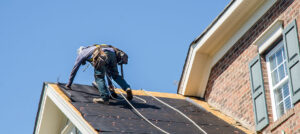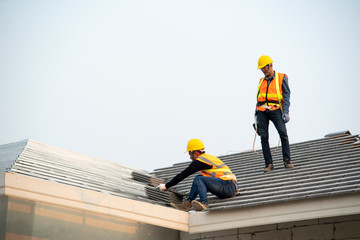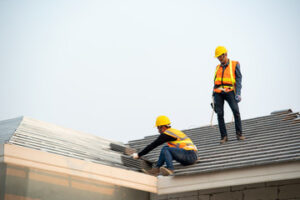Like basement waterproofing and window replacement, Roofing Columbus GA is a major investment for homeowners. But unlike these projects, it usually creates a strong return on that investment in terms of the house’s resale value.
Among the longest-lasting roofs are those made from natural slate. However, it is also possible to get an impressive amount of resale value from asphalt shingles.
Sheet metal roofing is a durable and attractive alternative to traditional asphalt shingles. The material can be made of several different types of metal, including zinc, tin, steel, and copper. It can also be finished with special coatings that reflect heat and prevent rust. Its low maintenance and long lifespan make it a good choice for homeowners. Choosing the right type of metal for your roof will depend on your area’s climate and weather patterns. For example, areas with harsh winds may need a more durable material.
Metal roofs come in many shapes and sizes, but they are mainly composed of flat or profiled panels that can be prefabricated or formed on site. These panels are joined by either standing seams or rolled joints. The standing seams are the most weather-tight and feature concealed fasteners. It can be made from steel or aluminum and is available in a variety of finishes, colors, and gauges.
Another popular option is metal shingles, which are molded into the shape of real shingles or other roofing materials. These can be painted to match any color scheme. They can be made of galvanized metal or a combination of different metals, such as stainless steel and aluminum. They are usually coated with a reflective coating, which helps reduce energy costs by reflecting sunlight and reducing heating in the summer.
A historic flat-seam metal roof is made of a series of interlocking copper or galvanized sheets that are hammered flat and soldered together. They are often found on church steeples and other historical buildings. They can also be curved to fit the curvature of the roof. A curved roof requires a more complicated seam system than a straight one.
A corrugated metal panel is a sheet of steel that has been strengthened by forcing it through a series of alternating grooves and ridges. This process increases its tensile strength and makes it more resistant to damage. It can be used in a wide range of building styles and is ideal for use on commercial or residential buildings. Heather & Little has extensive experience working on these types of buildings and can replicate historic practices while also understanding new best practices and viable material substitutions.
Metal roofs
Metal roofs are durable and can last 40–70 years, making them a good investment for homeowners in areas that experience high rainfall amounts or frequent hailstorms. They are also energy efficient, reflecting most of the sun’s heat instead of absorbing it. They can also withstand winds of up to 140 miles per hour and are fire-resistant. In addition, they don’t corrode or need the costly periodic maintenance that traditional roofing materials often require.
The most common types of metal roofs are steel and aluminum. They can be made in a variety of colors and designs, including those that mimic the look of shingles or tile. They can also be curved, which makes them well suited for homes with a steep slope. The choice of metal is important because it will determine the lifespan and cost of the roof.
A metal roof can be used on a wide range of building structures, including residential and commercial buildings, barns, and agricultural structures. They can be found on both new and existing homes and are available in a variety of finishes, including galvanized and galvalume. They can also be curved and come in a variety of styles, such as standing seam and corrugated. They can be clad in copper, stainless steel, or even zinc.
When choosing a metal roof, homeowners should keep in mind that these systems may have different warranties depending on the type of panel, the manufacturer, and the environment in which they are installed. Some warranties include a lifetime limited warranty and a corrosion warranty. Others only offer a limited warranty for rust and the coating system.
The underlayment is an important part of any roof, but it is especially critical for a metal one. It prevents leaks and protects the metal panels from water, ice, vapors, and high temperatures. Felt underlayment is the most popular, but synthetic underlayments are also available.
Many homeowners choose a standing seam metal roof because it is easy to install, durable, and affordable. These roofs are designed to accommodate expansion and contraction, which would damage a conventional shingle roof. The raised metal seams stay interlocked, and the fasteners are concealed, which makes this a very sturdy roof.
Metal shingles
Metal shingles offer homeowners the best of both worlds, offering durable protection and timeless style. Compared to traditional asphalt shingles, they last twice as long and can save up to 30% on energy costs. They also add value to a home and are a good choice for homes in colder climates. However, they are not suitable for every type of home and may require additional maintenance to avoid rust or corrosion.
While they are less expensive than standing-seam metal roofs, metal shingles can still be quite costly for many homeowners. In general, they cost between $400 and $650 per square foot for materials and installation. They are made from either steel or aluminum and are usually coated in a Kynar 500 or Hylar 5000 factory-applied paint finish.
They are available in a variety of shapes, sizes, and colors, making them a versatile option for any home. The color of metal shingles can also be customized by using different granules. This can help create unique patterns that complement a specific architectural style. Additionally, they are very durable and can withstand almost any weather condition.
Another benefit of metal shingles is that they can be installed over most existing shingle roofs. This makes them a good option for many homeowners who want to increase the longevity of their existing roofing system. They can also be used to replace a wood shake or cedar shingle roof.
While metal shingles are durable, they can still suffer damage due to severe storms and heavy snowfalls. They also require a professional installer to ensure proper installation and maintenance. For example, metal shingles should be inspected for signs of damage or rust on a regular basis. They should also be cleaned regularly to prevent mildew and algae growth. In addition, if you have an older home, it may be necessary to install additional structural reinforcements.
Metal panels
Metal panels can add a modern look to any home or business, and they’re also durable and energy-efficient. They’re a great alternative to traditional roofing materials like asphalt shingles and clay tiles, which can become porous and absorb moisture over time. A metal roof, on the other hand, is non-porous and impervious to water and snow. These panels are also less expensive to maintain than shingle or tile roofs.
There are several different types of metal panel products on the market. These include single-skin, insulated metal panels (IMPs), and metal composite material (MCM) panels. Choosing the right one for your project depends on many factors, including aesthetic preferences and budgets. Another factor is the amount of maintenance required. Some metal panel types require more maintenance than others.
Single-skin metal panels are typically fabricated from flat plates and bent to a profile. They can be manufactured in a variety of thicknesses and lengths, and they’re available in a wide range of color options. They’re also durable and resistant to corrosion in all weather conditions. Some manufacturers offer prefabricated single-skin wall panels for fast, easy installation.
IMPs are a popular option for commercial and industrial projects, especially in high-rise buildings. These panels are insulated and can be used as roofing or siding. They’re made of aluminum, stainless steel, or copper and are designed to meet seismic and wind loads. They’re usually affixed to a secondary structural system of channels, studs, and supports.
Standing seam panels have a vertically ribbed appearance and can be locked together with special metal caps. They conceal the fasteners and provide a clean, finished appearance for walls and roofs. They can withstand a range of temperatures, and their locking mechanism helps prevent leaking. They’re also a good choice for retrofit applications because they can be installed over existing cladding.


 A water stain on your home’s ceiling may need to be addressed promptly but may not necessarily constitute an emergency roofing situation. Here are some common types of emergency repairs:
A water stain on your home’s ceiling may need to be addressed promptly but may not necessarily constitute an emergency roofing situation. Here are some common types of emergency repairs: